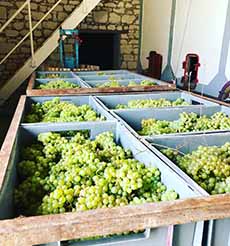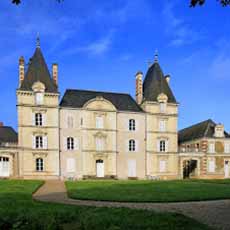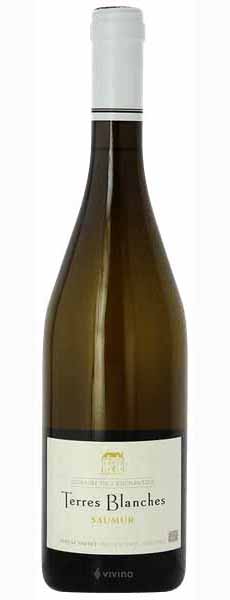TOP PICK OF THE WEEK: Chenin Blanc Wine From The Loire Valley
|
Our Top Pick Of The Week encourages you to try Chenin Blanc wines from the Loire Valley of France. These excellent white wines include familiar wines like Savennières and Vouvray, as well as other equally noteworthy but less-well-known white wines of the Loire. The Loire Valley (pronounced L-WAHR) is a paradise of beautiful scenery and stunning châteaux…plus wonderful cuisine, magnificent goat cheese, and world-beloved wines. Even in a country known for its centers of culinary excellence, the Loire Valley is known as the “Garden of France.” The Loire River nourishes its farms, orchards and vineyards; its forests are laden with game. There are medieval fortresses, impressive cathedrals, Renaissance mansions and bucolic manor houses. No wonder the kings of France and other nobles built chateaux there. On to the wines! But first: August 4th is National White Wine Day. > The year’s 22 white wine holidays.” > The year’s 25 red wine holidays. Below: > The history of Chenin Blanc wine. > Food pairings for Chenin Blanc. The Loire vinters produce red wines, white wines, rosés and sparkling wines, from grapes that include Chenin Blanc, Sauvignon Blanc and Melon de Bourgogne (white grapes), and Cabernet Franc, Gamay and Pinot Noir (red grapes). It can take a semester of study to know them all and years to understand them. Today, we’ll focus on Chenin Blanc wines (SHEN-in BLONK): principally, Anjou Blanc, Coteaux du Layon, Savennières and Vouvray. The grape is used to make a variety of wines, all named for the areas where they are produced. The best known is Vouvray. Chenin blanc (also as Côteaux de Layon, Pineau de la Loire and Steen [in South Africa]) is a white wine grape variety that originated in the Loire Valley, but is planted the world over. Some trivia: The most planted grape in South Africa is Chenin Blanc, where the acreage planted is double that in the Loire region! Beyond South Africa and France, there are major plantings in Australia, California, New Zealand, South Africa and South America (Argentina, Brazil, Mexico and Uruguay). Today, we focus on Chenin Blanc in its home region, the Loire Valley, a 100-mile stretch of land between the towns of Blois at the east end and Savennières at the west end*. The grape’s high acidity gives it versatility to make everything from still wines to sparkling wines to dessert wines. Unlike any other grape except Riesling, Chenin Blanc can be vinified in a range of styles—from austere, mineral and refreshing to rich, honeyed, and sweet (both grapes make great dessert wines). Its versatility surpasses Riesling in that it also makes excellent sparkling wine [source]. Like all wine grapes, Chenin Blanc yields different flavors and aromas based where it is planted: the terroir, vintage variation and winemaker’s treatment (oaked or non-oaked, chapetilization, type of barrels for aging, aging time before release, e.g.). As with all wine grapes, the terroir‡‡ of the region where they grow will largely dictate whether Chenin blanc is produced in a predominately sweet or dry manner, while the vineyard soil type will generally influence the overall style of the wine. While in some areas of the world, Chenin Blanc grapes are decent and will create a “workhorse variety” of wine or a blending grape used for its acidity, in the Loire Valley the grape is prized as a premium quality, able to produce world class wines. First, a note about French wine labeling. In France, wines are called by the towns or regions where they are made, not by their grape variety. Thus, you buy “White Burgundy,” not Chardonnay; or “Bordeaux,” not Cabernet. In the Loire, you buy Anjou Blanc (a villages wine**), Savennières (a designated wine of Anjou) or Vouvray, not Chenin Blanc. Both are AOC wines. What’s the difference? Terroir‡, and winemakers’ individual “recipes” (i.e., how they make their wines). The Chenin Blanc grape may have been brought to the Loire Valley more than 1,000 years ago. But viticulture there began much earlier. The Loire Valley’s climate attracted the ancient Romans, who conquered and annexed Gaul and planted the first vineyards there during their in the 1st century C.E. In 1999, DNA analyses revealed that Chenin blanc is an offspring of the Jura wine grape Savagnin, and that it has a sibling relationship with Sauvignon Blanc. There are enough Chenin Blanc styles to appeal to different food pairings. |
|
|
|
Why does the Loire Valley specialize in goat cheese? Of the hundreds of types of French cheeses, only 48 are protected with AOC† status. Six of these are from the Loire Valley, where the signature cheese is chèvre—goat cheese in English. As the [somewhat apocryphal] story goes, in 732, the Franks and the Umayyad Caliphate of the Middle East fought the Battle of Tours in the central Loire Valley. The Franks were victorious, and as the Umayyad (called Saracens by the Europeans of the time) were driven south, they supposedly left their goats behind. Ever since then, goats have been plentiful inhabitants of the Loire Valley. No place on earth makes such acclaimed goat cheese, including the AOC standouts: Chabichou de Poitou, and Crottin de Chavignol, Pouligny-Saint-Pierre, Sainte-Maure de Touraine, Selles-sur-Cher and Valençay. It is the French way, all named for the villages that produce them. What time is it? Time to grab a bottle of Vouvray and some different goat cheeses, and take a break. The Massif Central, an upland area in south-central France is bordered by the lowlands of Aquitaine on the west, the Paris Basin and the Loire River valley on the north, the Rhône-Saône river valley on the east, and the Mediterranean coastlands of Languedoc on the south. †AOC, an abbreviation of appellation d’origine contrôlée, is a legal designation that places rigid standards on how and where a French product can be produced. This ensures consistent quality and preserves its reputation. Vin délimité de qualité supérieure, usually abbreviated as VDQS, was the second highest category of French wine, below Appellation d’Origine Contrôlée in rank, but above Vin de Pays. ‡ Pouilly-Fumé is made from the Sauvignon Blanc grape in the Loire Valley; Pouilly-Fuissé is made from the Chardonnay grape from Maconnais region of Burgundy. Pouilly is a place name. Fumé means smoky, referring to the gunflint aroma that characterizes the wine. Fuissé is the name of the commune where Pouilly-Fuissé is produced. ‡‡Terroir, pronounced tur-WAH, is a French agricultural term referring to the unique set of environmental factors in a specific habitat that affect a crop’s qualities. It includes climate, elevation, proximity to a body of water, slant of the land, soil type and amount of sun. These environmental characteristics gives the wine (or other agricultural product) its character. A villages (vih-LAJZ) wine is made with grapes that can grow anywhere in the region (e.g., Anjou). A Savennières wine is made from grapes grown specifically in the Savennières area. Designated locations are superior to villages wines. CHECK OUT WHAT’S HAPPENING ON OUR HOME PAGE, THENIBBLE.COM.
|
||










